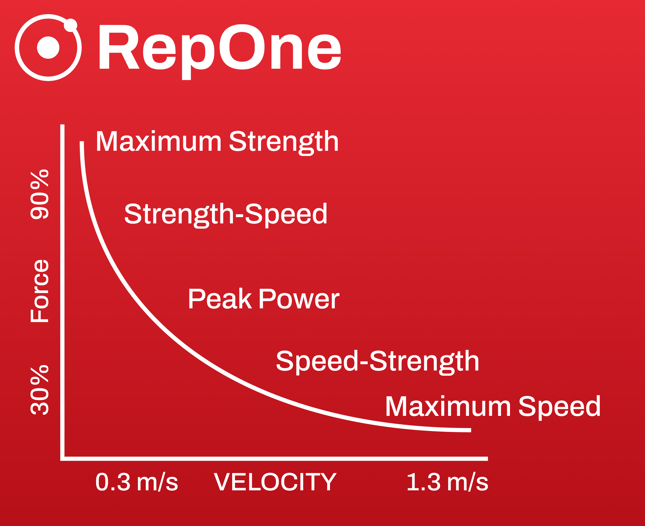Velocity Based Training is great, but what are you supposed to do with the data? That's a question we get constantly, because we aren't all PhD's in Mathematical Statistics. Luckily Brendan Burke is, and when he reached out to tell us he could improve our RPE/velocity correlation tables, we knew we had to release VBT for Powerlifting 2.0 to help our powerlifting customers manage their data.
The heart of the new program is our setup tables and correlation tables. In this program they serve as the backbone for load prescription, but once filled, you can use these tables for any program where RPE is useful. This style of VBT is has a lot of names, but we call it load prescription via velocity thresholds, or velocity cutoffs. The simplest version of this method of VBT would be to take a generalized chart like the well known Force Velocity curve, and use that to prescribe loads for a group of athletes.

This type of chart works well for coaches who have a lot of athletes and don't have the bandwidth to individualize these targets. Athletes who don't competitively train a movement tend to have a velocity @ 1RM of somewhere around 0.3 to 0.4 m/s.
With that said, there are a couple of problems with this approach. First and less relevant to this blog post is the modern (and semi-controversial) philosophy of exercise science specificity, and the framing of this chart in general. This chart suggests we should prescribe velocity thresholds based on force production regimes. There's an emerging body of research that suggests a "speed-strength" regime doesn't actually improve athletic force production at those speeds, it simply improves the athletes force production during that exercise at that speed. If we take this to be true, then defining a correlation table in this manner leads us down a periodization path that's not conducive to our goals.
More relevant yet is the argument that 0.3 to 0.4 m/s may be velocity @ 1RM for some, but not even close for others. Set aside exercise specialization for the moment and consider a 6'6" receiver squatting next to a 5'9 running back. a 0.4 m/s squat may land the receiver close to a 1RM squat, while the running back is still warming up.
For these reasons, we like to use a more sport specific and individualized tool to prescribe load.

No, this isn't a real data set. If you can hit a bench single consistently at 0.03 m/s you might be an actual sloth.
I know, that's a lot of numbers. We don't like it either. But it's a simpler tool than it looks at first glance. Let's start with the first column, RPE 6. If you want to do an RPE 6 set at each one of these rep ranges, you can use this chart to arrive at an individualized velocity target. 0.49 m/s for 10 reps at 6 RPE, 0.19 m/s at 1 rep at 6 RPE (again, this is not real data).
Moving onto the rows, let's start at 1 rep per set. If you travel across from RPE 6 to RPE 10, you'll see an increase of roughly 0.02 to 0.03 m/s per additional rep. That's called the MWC, or minimum worthwhile change. Often that delta V represents about 5-10 lbs or one rep in reserve worth of velocity loss. You can use that first row to estimate how close to failure a specific velocity target will get you.
You'll notice the setup charts only have rows available for sets of 2, 5, and 8. That's because we want to reduce the amount of data you need to complete this chart from scratch. We use simple interpolation to fill anything that's blacked out. If you want to start the program but you don't have the data to fill these charts, simply hit the check box on the top right of tab 1 and include your 1RM load and estimated V1RM, and the program will switch over to a MWC method for load prescription.
Once you fill the setup tabs for squat and bench, these charts will be ready to help you individualize load on any program. If you choose to use this program, those loads will be autofilled based on the prescription we're giving you.
Beyond the MWC method, and the RPE/Velocity correlation table method, there's a third method you can use to autoregulate this program. Day 3 includes a plus set (AMRAP) for both squat and bench. You can use the resultant number of reps and a 1RM calculator to estimate what your new 1RM is each week, and then use the percentage chart in the calibration tab to prescribe loads for each session.
The program
The program itself is very simple. It's a beginner/intermediate powerlifting program with very few tier 2/3 accessories. The goal is to periodize the important work, and let you have fun with the remaining time you have to train. The periodization method is Daily Undulating, the deadlift clusters are inspired by SSPT, and the deadlift accessories are inspired by the Coan Philipi Deadlift Program. We call it a beginner/intermediate program because the amount of weekly training volume for squat and bench are around 60-70 reps. Advanced powerlifters can exceed 100 reps per week of competition specific training volume.
That's it, you're ready to go. Feel free to duplicate the spreadsheet and edit it with your data. If you have any VBT programs of your own that you'd like us to share, please reach out. We'd be happy to send it to our audience.